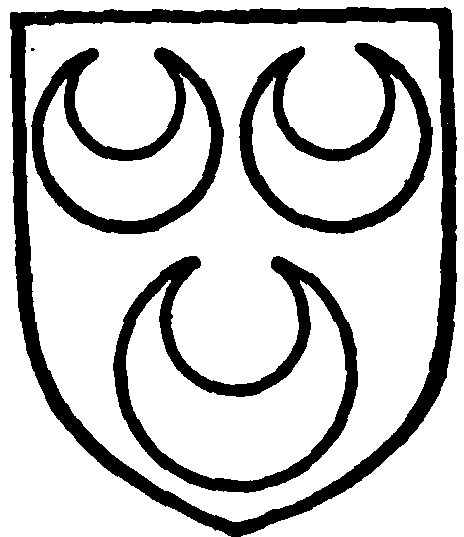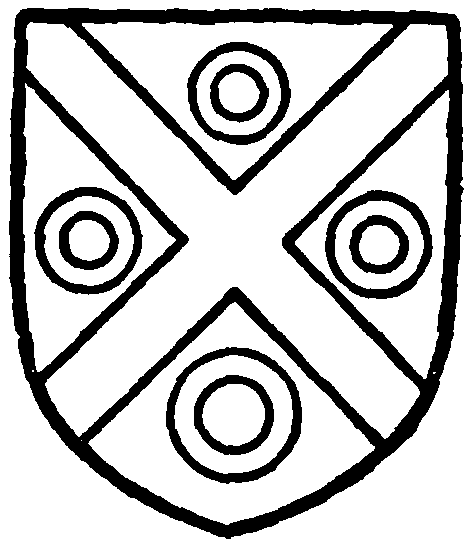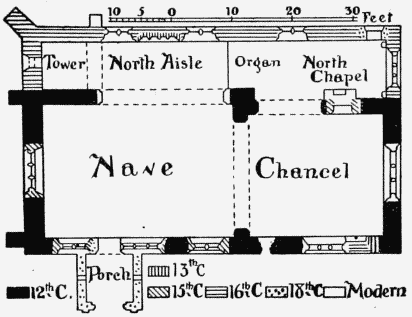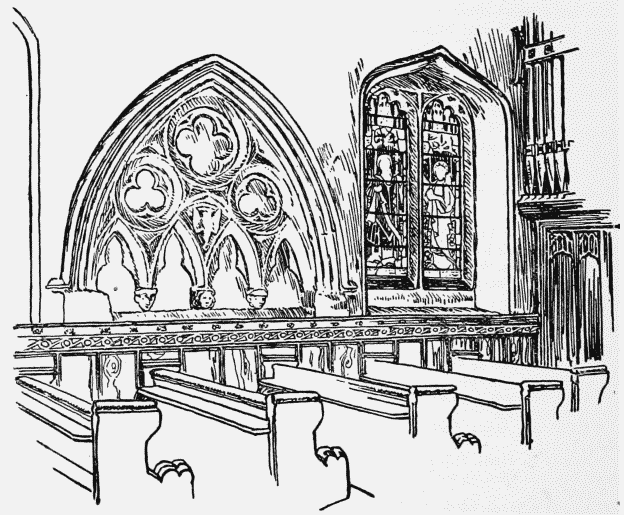A History of the County of Hertford: Volume 3. Originally published by Victoria County History, London, 1912.
This free content was digitised by double rekeying. All rights reserved.
'Parishes: Digswell', in A History of the County of Hertford: Volume 3, ed. William Page (London, 1912), British History Online https://prod.british-history.ac.uk/vch/herts/vol3/pp81-85 [accessed 22 February 2025].
'Parishes: Digswell', in A History of the County of Hertford: Volume 3. Edited by William Page (London, 1912), British History Online, accessed February 22, 2025, https://prod.british-history.ac.uk/vch/herts/vol3/pp81-85.
"Parishes: Digswell". A History of the County of Hertford: Volume 3. Ed. William Page (London, 1912), British History Online. Web. 22 February 2025. https://prod.british-history.ac.uk/vch/herts/vol3/pp81-85.
In this section
DIGSWELL
Dicheleswell (xi cent.); Digeneswell, Dikneswell (xiii cent.); Digoneswell (xiv cent.); Dikkeswell, Dixwell (xvi cent.); Diggeswell (xvii cent.).
The parish of Digswell has an area of 1,673 acres, of which 746¼ acres are arable land, 465¾ acres permanent grass, and 18¼ acres wood. (fn. 1) The land reaches an elevation of over 400 ft. in the south, where the rectory and Sherrard's Park Wood are situated, but is lower in the north, sloping down to the River Mimram, which crosses the parish in that part. The northern part of the parish is divided from the southern by an irregular strip of the parish of Welwyn. It lies at an altitude of from 300 ft. to 400 ft. The larger part of it has been developed by a syndicate, and is now covered with houses; its western boundary takes in a small portion of the hamlet of Burnham Green. A detached portion of Welwyn parish was added to Digswell for ratable purposes under the Divided Parishes Act of 1882.
The village of Digswell is situated in the valley of the Mimram, in an open space surrounded by the park, the church and manor-house, the seat of Mr. Alfred Dyke Acland, lying at the south-western end. From these a long avenue called the 'Monk's Walk' leads to the rectory and Sherrard's Park Wood. In the east of the parish, on the main road from Welwyn to Hertford, is the hamlet of Digswell Water, now recognized as the village of Digswell, though some way from the church. It was probably here that the market was held. The Great Northern railway passes through the parish, crossing the valley of the Mimram by a viaduct. The nearest station is Welwyn, half a mile north-east. The subsoil is chalk in the north, and London Clay and Reading and Woolwich beds in the south. There are two disused chalk-pits in Digswell Park, another near Digswell Lodge Farm, and a fourth in the north-east. A large gravel-pit is still worked south of Digswell Water, and there are several disused ones further down the road.
The following place-names occur in the middle of the 17th century: the Malmes, Dockclose, the Scrubbs, Cowmead, Henley hill, Conduck hill, Tylekill field, Piggott hill, Estoll hill, and Hatches wood. (fn. 2)
MANOR
Before the Conquest DIGSWELL formed part of the lands of Asgar the Staller, and was subsequently granted to Geoffrey de Mandeville, being then assessed at 2 hides. (fn. 3) One hide, which had been held by Topi, a man of Almar, presumably Ælmar of Benington, was in 1086 in the possession of Peter de Valognes. (fn. 4) This hide, which was held by a certain Roger, probably became absorbed in the manor, as it is not heard of again; half the multure of one of the two mills at Digswell belonged to this estate in 1086. (fn. 5)
The lands of Geoffrey de Mandeville descended to his grandson Geoffrey, first Earl of Essex, (fn. 6) and remaining with the holders of that earldom (fn. 7) came to Maud the heiress of the Mandevilles, who married Henry de Bohun Earl of Hereford and died in 1236. (fn. 8) The Earls of Hereford and Essex continued to hold Digswell (fn. 9) until their lands were divided between the daughters of Eleanor, daughter and co-heir of Henry de Bohun, and King Henry V, who represented her sister Mary. (fn. 10) Digswell thus came into the possession of the Crown, and was thenceforward held of the king, of the duchy of Lancaster, as of his manor of Hertford by fealty and the rent of 6d. or one pound of pepper, to be paid yearly at Christmas. (fn. 11)
In the time of Edward the Confessor and in 1086 the sub-tenant of Digswell was Torchil (fn. 12); he was one of the Domesday jurors for Broadwater Hundred, (fn. 13) but nothing is known of his descendants. Between 1167 and 1189 the manor was granted by William de Mandeville to William son of Benedict of London, (fn. 14) who seems to have been also known as William de St. Michael. (fn. 15) In 1223 Laurence de St. Michael, son and heir of William de St. Michael, did homage for lands in Nottingham, (fn. 16) and in 1248 this Laurence is called son of William son of Benedict. (fn. 17) Laurence died some time previous to 1268, for in that year his widow Ada complained that malefactors had lately come to her manor of Digswell and taken her goods and chattels to the value of 100 marks and more. (fn. 18) The manor passed before 1274 to another Laurence de St. Michael, (fn. 19) presumably her son, who died about 1283, leaving a son Laurence (fn. 20) and a widow Margaret. (fn. 21) This Laurence obtained a licence in 1285 to stop a path through his wood of Slirigge, leading from Digswell to Bishop's Hatfield (where he held the manor of Ludwick), on condition that he made another path on the east side of the wood. (fn. 22) In 1291–2 he closed a path running through the middle of 'Chirchegrave,' and made another which, he averred, would be much more useful. (fn. 23)
The manor was shortly afterwards acquired by William de Melksop, who received a grant of free warren in his lands in Digswell in 1301–2. (fn. 24) These lands were probably not the manor, for the latter was not conveyed to him by Laurence de St. Michael until 1305. (fn. 25) This William had been assessor for a subsidy in Surrey in 1297 (fn. 26); in 1298 he was appointed attorney for two years to Stephen, Prior of Holy Trinity, London. (fn. 27) In 1300 he and John de la Leye were commissioned to survey the obstructions in the river leading from Ware to the Thames. (fn. 28) In 1304 William de Melksop was keeper of the manor of Clopton, formerly part of the possessions of Edmund Earl of Cornwall, (fn. 29) and about the same time he bought from the executors of the same Edmund the custody of the lands of Hamo de Gatton, which in 1305 he sold to John de Northwode. (fn. 30) In 1313 and again in 1315 he received licence to go 'beyond seas' with Aymer de Valence. (fn. 31) He died about 1317, having been for some time previous to his death farmer of the king's castle and manor of Hertford, where he had executed extensive repairs. (fn. 32) He had a son William, (fn. 33) who in 1318 received a pardon for killing William de Ponton at a tournament at Luton. (fn. 34) Henry de Melksop is mentioned as of Digswell in 1323, (fn. 35) but apparently the manor was alienated soon afterwards, for by 1346 (fn. 36) it had come into the possession of William de Ludwick, (fn. 37) from whom it passed to his son John de Ludwick before 1377. (fn. 38) In 1414 it was conveyed by Ludwick's feoffees to John Perient, (fn. 39) who according to the monument to him in the church died in the following year. He was succeeded by his son John, from whom it passed in 1432 to his son John, (fn. 40) who died in 1442. (fn. 41) He was succeeded by Edmund Perient, who died in 1474, when Digswell came to his son Thomas. (fn. 42) In 1539 Thomas Perient the younger succeeded, (fn. 43) and died in 1545, leaving four daughters, Mary the wife of Affabell or Amphabell Rowlett, Dorothy, Anne, and Elizabeth. (fn. 44) Digswell came to Mary, the eldest daughter, whose first husband died in 1546, (fn. 45) and who married secondly George Horsey, and held the manor until her death in 1551. (fn. 46) It was then divided between her sisters Dorothy, who had married George Burgoyne, and Anne the wife of Anthony Carleton (fn. 47); Elizabeth had presumably died in the mean time. In 1552 Anne and Anthony Carleton conveyed their moiety back to George Horsey, (fn. 48) who had just married Anne Sadler, (fn. 49) and in 1557 he acquired the second half from George and Dorothy Burgoyne. (fn. 50) Ralph Horsey succeeded his father (fn. 51) before 1591, (fn. 52) and in 1599 conveyed Digswell to John Sedley and Nicholas Hyde. (fn. 53) John Sedley died in 1605 seised of half the manor, which passed to his brother William. (fn. 54) Apparently the moiety held by Nicholas Hyde also came to him, for in 1656 he sold the whole manor to Humphrey Shallcross. (fn. 55) The latter died in 1665, (fn. 56) and was succeeded by his son Francis Shallcross, (fn. 57) and his grandson Francis Boteler Shallcross in 1681. (fn. 58) The last-named died without issue in 1693, (fn. 59) and Digswell passed to his uncle Henry Shallcross, (fn. 60) who died in 1696. (fn. 61) Henry's son Thomas is mentioned as lord of the manor in 1728 (fn. 62) and 1729, (fn. 63) and William Shallcross in 1757. (fn. 64) He was succeeded by another Thomas Shallcross, who died in 1770 (fn. 65) and left Digswell to Richard Willis, the husband of his niece. (fn. 66) Elizabeth Willis, their daughter, sold the manor in 1786 to Henry Cowper. (fn. 67) The latter occupied the position of guardian to the young Earl Cowper, (fn. 68) and the sale was in reality to his ward, for the earl was in possession of the manor in 1821. (fn. 69) Digswell remained in the possession of the Earls Cowper uncil the death in 1905 of the seventh and last earl, whose trustees are at present lords of the manor.

Perient. Gules three crescents argent.

Shallcross. Gules a saltire between four rings or.
The manor of Digswell possessed two mills as early as 1086, at which time a half mill was held by Roger of Peter de Valognes. (fn. 70) Two mills, together with a carucate of land, were the subject of a fine in 1233 between Simon Fitz Simon and Henry Sifriwast, (fn. 71) to one of whom they had doubtless been leased by the lord of the manor. They are mentioned as late as 1786, (fn. 72) but only one exists now.
Laurence de St. Michael in 1274 had free warren on one side of the river, and claimed it on the other side. (fn. 73) He also claimed at the same time view of frankpledge, gallows, and amendment of the assize of bread and ale. (fn. 74) William de Melksop received a fresh grant of free warren in 1301–2. (fn. 75) In 1278 Laurence de St. Michael claimed by charter of Henry III a weekly market on Thursdays and a fair every year for ten days. (fn. 76) Neither now survives. They probably died out owing to decrease in the population, caused presumably by the Black Death, for in 1428 Digswell only possessed six householders. (fn. 77)
CHURCH
The parish church of ST. JOHN (fn. 78) is covered with cement outside and plastered inside, and consists of a chancel, nave, north chapel and north aisle, north-west tower, and south porch.
The original church, probably consisting of a chancel and nave, was built in the 12th century, and to that date the present chancel and nave may probably be referred. The north aisle was built about 1300, with a chantry chapel added at its east end a quarter of a century later, but the arcade no longer exists.
In the first decade of the 16th century the present north chapel was built, replacing the smaller chantry, for the erection of which John Perient left £200 at his death in 1324 for the souls of himself, his wife and parents, and John Ludwick and John Derham. (fn. 79) At the same period the north-west tower was added to the west of the aisle, its north and west walls being continuous with those of the aisle and nave. The south porch seems to belong to the end of the 17th or the beginning of the 18th century. The church was extensively altered in 1811, and was restored in 1874.
The chancel has a modern east window of three lights in a two-centred head. On the north side is an arch of about 1200 opening into the north chapel. The face towards the chancel is modern. The arch is two-centred of a single chamfered order; to the east of it is a deep recess with a four-centred head, of the 15th century, which may have been originally open on both sides. In the south wall at the east is a modern three-light window with a square head. At the west end of this wall is a lofty segmental-headed window, probably of the 13th century, now blocked. To the east of the easternmost window in the south wall is a double piscina of the 13th century with two high two-centred chamfered heads and a central shaft, of which the base is old.

Plan of Digswell Church
Between the chancel and the chapel is a screen of the early 16th century, of which the lower part has been destroyed. A similar screen, formerly the rood screen, with the lower part also destroyed, divides the chapel from the aisle. The north chapel has two early 16th-century windows, that in the east wall having three trefoiled lights in a four - centred head, and the north window two cinquefoiled lights in a square head. At the northeast corner is a small door with a two-centred head, leading to the churchyard. On each side of the east window is a stone bracket, moulded and carved with shields of Perient, three crescents quartering a cross paty. It is possible that these may have been originally in John Perient's chantry. The roof of the chapel is low pitched, of panelled oak, and dates from the early 16th-century remodelling.
The nave walls are probably of the 12th century, but there is no detail of an earlier date than the 15th century. There were three windows in the south wall, but the middle one of three lights is blocked by the east wall of the porch; the other two contain some 15th-century stones and are of two cinquefoiled lights with tracery above in a two-centred head. The west window is of three lights with tracery above in a two-centred head. The roof has 15th-century tie-beams. The south door opens to the cemented and embattled porch, which has a small light in the east and west walls.
The north aisle opens to the nave by a single modern arch, which replaces the original arcade of two bays. In the north wall are two-light cinquefoiled windows of the same date as those of the chapel, and obviously inserted when the chapel was rebuilt. Between them is a remarkable recess with a richly moulded two-centred arch, containing tracery of the end of the 13th century. The lower part of the recess is destroyed, but the tracery is intact and consists of four high trefoiled heads, supported on three corbels with the heads of a priest, a woman and a bishop, and having above them two trefoils surmounted by a quatrefoil, the space in the middle being filled by the dove, the symbol of the Holy Ghost. The lower part of the label of the arch, with returns, is modern.
The north-west tower has a north wall of the same thickness as that of the nave. It is open only to the aisle by a four-centred plastered arch. The oak doors in this arch, of early 16th-century work, were probably originally those of the rood screen. They have traceried and moulded panels and a fourcentred cusped and foliated head. The west window of the tower is of a single light, of the 16th century. It is unglazed and closed by a door. The four bellchamber windows are also of the 16th century, of two cinquefoiled lights under a square head.
In the chapel are mural monuments to William Sedley, 1658, Eliza Shallcross, 1677, and Francis Shallcross, 1681, and some 17th-century floor-slabs to members of the Shallcross family. There is in the chancel a brass of John Perient, standard-bearer to Richard II, Henry IV, and Henry V, and his wife Joan Risain, who died in 1415. The figures are 5 ft. long. The man is in armour, and the arms and part of the inscription remain. Another brass of a knight in armour, with two symbols of the Evangelists, is most probably that of his son John Perient, who died in 1432. On the same slab is an inscription to Thomas Robynson and his wife, 1495. A brass of Thomas Hoore, 1495, his wife, four sons and eight daughters, has an inscription and four shields with a double-headed eagle, the arms of Hoore, the Mercers' Company and a defaced coat. There are also in the chancel brasses of William Robert, auditor of the Bishop of Winchester, 14—(the date has not been filled in), his wife, 1484, and two sons; the figures are shrouded and there are two shields and an inscription: of John Perient, a small, undated inscription; of Robert Battyl, 1552, his wife, four sons and six daughters; and of two daughters of Sir Alexander Cave, 1637.

Digswell Church: North Aisle, Showing Recess With Tracery
The bells are three in number, the first and second by Robert Oldfeild, 1605.
The plate includes an engraved cup of 1563, a paten of 1673 and a flagon of 1672.
The registers are in three books: (i) all entries from 1538 to 1731; (ii) baptisms and burials from 1731 to 1812 and marriages from 1731 to 1753; (iii) marriages from 1758 to 1812. Book i has been recovered since the return of 1830.
ADVOWSON
The church was given to the abbey of Walden, in Essex, by Geoffrey de Mandeville, first Earl of Essex, the founder of that monastery (fn. 80) and lord of the manor of Digswell. The grant was confirmed by Alice de Vere, (fn. 81) said to have been the sister or half-sister of William de Mandeville, the third earl. (fn. 82) Geoffrey Fitz Piers, who was Earl of Essex from 1199 to 1213, (fn. 83) laid claim to the advowson, and litigation arose between him and the Abbot of Walden. It was decided that the earl and his son Geoffrey should present to the church during their lives, and that after their decease it should return to the abbot for ever. (fn. 84) The advowson then remained to Walden Abbey until the surrender of the abbot in 1533. (fn. 85) The church was never appropriated, and the living was always a rectory. In 1538 the abbey, at the earnest suit of Thomas Audley, then Lord Chancellor, (fn. 86) was granted to him with all its possessions, (fn. 87) among which, however, Digswell advowson is not mentioned. (fn. 88) Although there is no record of any grant, (fn. 89) the advowson seems to have been acquired by the lords of the manor, for John Sedley was seised of half of it at his death in 1605. (fn. 90) After that date it descended with the manor until 1786, (fn. 91) when it was sold by Elizabeth Willis to Jane Pearce, (fn. 92) who left it by will to her nephew the Rev. Nathaniel May, (fn. 93) the patron in 1811. (fn. 94) In that year, however, he sold it to Joshua Watson, to hold in trust for the use of his brother the Rev. John James Watson and his heirs. (fn. 95) In 1829 the advowson was sold by Dr. Watson to S. Everard, (fn. 96) who again sold it late in 1836 to William Willoughby Prescott. (fn. 97) The latter died in the same year, leaving it by will to his fourth son, the Rev. George Edward Prescott, who was patron and incumbent until 1888. (fn. 98) His trustees held the presentation from that date until 1900, when it was acquired by Miss Wilshere (fn. 99) of the Frythe, Welwyn, who is the present patron.
In 1638 the parsonage of Digswell was said to be 'sufficient and commodious for habitation.' Adjoining there was 'one large nue barne thatched and bourded on the outside, of length five bayes, also one hay barne and stable nue built conteining both fower bayes covered with tiles being all under one roofe.' The glebe lands amounted to 40 acres. (fn. 100)
CHARITIES
The parliamentary returns of 1786 mention certain tenements and land held by the parish under a gift of Thomas Shallcross and of a donor unknown, situated respectively at Burnham Green and at Harmer Green. Questions arose, however, as to the title of the parish to the property at Burnham Green, but three small tenements at Harmer Green were inhabited by three poor families rent free.
